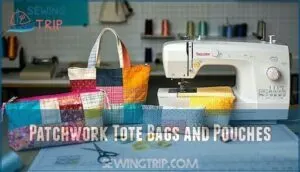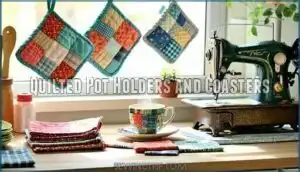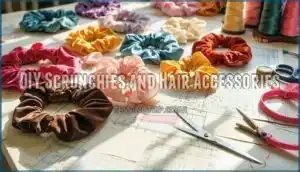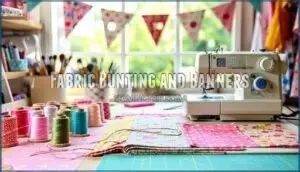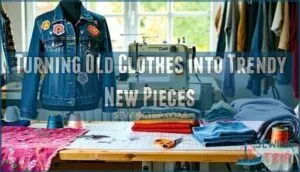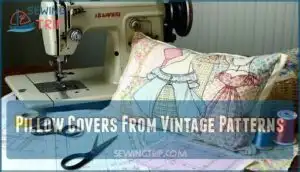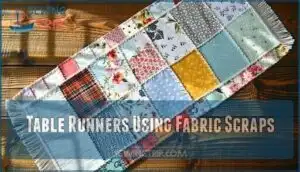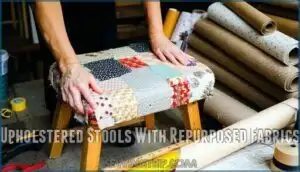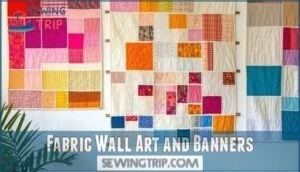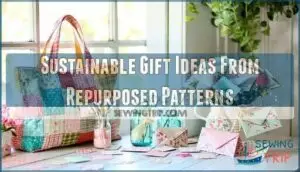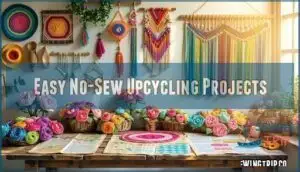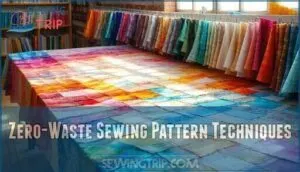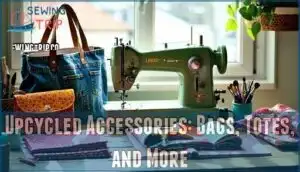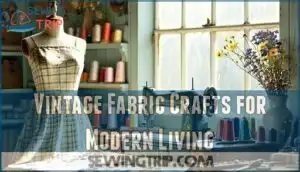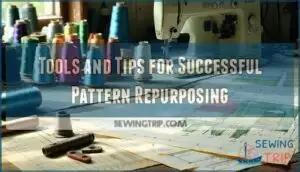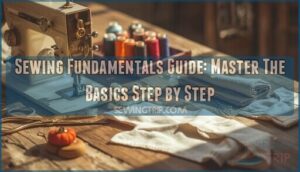This site is supported by our readers. We may earn a commission, at no cost to you, if you purchase through links.
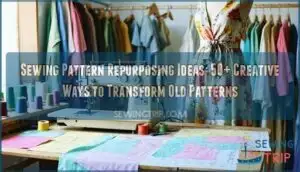
Kid-sized patterns are surprisingly perfect for grown-up accessories. Those tiny bodice pieces? They make great headbands. Small sleeves become phone cases. And don’t even get me started on how a child’s collar pattern transforms into the cutest scrunchie.
Here’s where it gets fun though – grab pieces from totally different patterns and frankenstein them together. That vintage blazer lapel plus a modern dress waistband? Now you’ve got something completely new.
Even vintage patterns hiding in your grandmother’s sewing box can become modern statement pieces when combined with contemporary fabrics and techniques.
Table Of Contents
- Key Takeaways
- Creative Ways to Repurpose Sewing Patterns
- Upcycling Fabric Scraps Into Functional Items
- Turning Old Clothes Into Trendy New Pieces
- Sewing Pattern Hacks for Home Decor
- Sustainable Gift Ideas From Repurposed Patterns
- Easy No-Sew Upcycling Projects
- Zero-Waste Sewing Pattern Techniques
- Upcycled Accessories: Bags, Totes, and More
- Vintage Fabric Crafts for Modern Living
- Tools and Tips for Successful Pattern Repurposing
- Frequently Asked Questions (FAQs)
Key Takeaways
- Transform old patterns into multiple new projects – Cut dress patterns at different points to create crop tops and skirts, or repurpose sleeve pieces into trendy bags and pouches, utilizing their natural curved shapes.
- Mix and match pattern pieces creatively – Combine sleeves from one design with bodices from another, blend different necklines, or merge collar styles from children’s patterns onto adult garments for unique hybrid pieces.
- Turn fabric scraps into functional items – Create patchwork tote bags, quilted pot holders, DIY scrunchies, and fabric bunting from leftover materials instead of discarding them.
- Use zero-waste techniques for maximum efficiency – Arrange pattern pieces like puzzle pieces, fold and tessellate designs to fit together perfectly, and create modular layouts that eliminate fabric waste by utilizing every inch of material.
Creative Ways to Repurpose Sewing Patterns
You don’t need to start from scratch when you want something new to sew. Your old patterns are treasure chests waiting to be unlocked with fresh ideas that’ll surprise you.
Mix and match pieces, chop dress patterns into trendy tops, or turn those sleeve pieces into cute pouches that everyone will ask about.
Transforming Dress Patterns Into Tops or Skirts
Ever wonder what to do with that gorgeous dress pattern that’s just a bit too fancy for your everyday wardrobe? Try pattern hacking!
Cut the bodice at the waist for a chic top, or skip the bodice entirely for a flowing skirt. These style adaptations breathe new life into forgotten sewing projects while upcycling patterns you already own.
Using Sleeve Patterns for Bags and Pouches
You know those sleeve patterns collecting dust in your sewing box? They’re actually perfect for making stylish bags and pouches that’ll turn heads.
Transform sleeve gussets into structured pouches by adding zipper placement at the top and lining options for durability. Scale patterns up for larger tote bags or down for coin purses.
Handle attachments work perfectly where sleeve seams originally connected, making these upcycling sewing projects both clever and sustainable.
Adapting Children’s Patterns for Accessories
You know those tiny kids’ sewing patterns that seem useless for grown-ups? Think again. They’re goldmines for making cool pouches, bags, and decorative pieces that actually look sophisticated.
Transform tiny dress patterns into scaled-down bags or mini backpacks that are ideal for carrying essentials. You can repurpose toy accessories patterns by mixing fabric scraps through pattern mashups, adding embellishment ideas like embroidery or buttons to create one-of-a-kind pieces that showcase your upcycle and DIY sewing skills.
Combining Pattern Pieces for New Designs
Pattern pieces work like Lego blocks for sewists. You can pull sleeves from one design, match them with a bodice from another, and end up with something nobody’s seen before. It’s pattern hacking at its best.
When you start mixing elements from different designs, you’re not just following instructions anymore. You’re designing. Take those dramatic bell sleeves from your grandmother’s vintage pattern and pair them with a sleek modern top. Or grab a cowl neckline and drop it onto a completely different bodice.
Here are five ways to get creative with your pattern pieces:
- Mix sleeve styles – Take bell sleeves from a vintage pattern and sew them onto a modern fitted top.
- Blend necklines – Combine a cowl neck with a different bodice for dramatic effect.
- Create hybrid skirts – Join an A-line front with a pencil skirt back for unexpected movement.
- Merge collar designs – Add a Peter Pan collar from children’s patterns to adult garments.
- Layer pattern elements – Use vest pieces over dress patterns for sophisticated layering.
This approach turns basic sewing into something that’s completely yours. Your finished pieces won’t look like everyone else’s because they started with your vision, not just a pattern company’s idea.
Upcycling Fabric Scraps Into Functional Items
Those leftover fabric scraps don’t have to end up in the trash bin. You can transform them into beautiful, practical items that’ll make your home more organized and stylish.
Patchwork Tote Bags and Pouches
Your fabric scraps are about to become your new favorite shopping companions. Start with pattern piece placement on sturdy canvas or denim for structure, then sew colorful fabric scrap combinations into eye-catching patchwork designs.
Use reinforcement techniques at stress points, add cotton lining options for durability, and secure handle attachments with double stitching for bags that’ll carry everything beautifully.
Quilted Pot Holders and Coasters
Turn your kitchen into a cozy sanctuary with quilted pot holders that actually protect your hands from scorching pans. Heat Resistant Fabrics like cotton batting work perfectly with the Quilt-As-You-Go method for quick results.
- Use Pattern Scaling to resize any sewing pattern into perfect potholder dimensions
- Try various Coaster Shapes – squares, circles, or hexagons from fabric scraps
- Master simple Binding Techniques to finish edges professionally
- Create matching quilted coasters using leftover quilts pieces
These functional beauties transform forgotten fabric scraps into kitchen essentials you’ll actually use daily.
DIY Scrunchies and Hair Accessories
Small fabric scraps suddenly become your secret weapon for creating hair accessories that cost a fortune at boutiques.
Transform those leftover scrunchie fabrics into elastic headband styles using simple pattern alterations. Mix bow variations with different elastic types for handmade gifts that showcase your DIY sewing skills.
These quick sewing projects turn forgotten fabric scraps into trendy accessories everyone will love.
Fabric Bunting and Banners
Imagine this: colorful fabric triangles dancing in the breeze, instantly transforming any space into a celebration. Creating patterned bunting from fabric scraps turns forgotten materials into stunning celebration decor.
You’ll upcycle old sewing patterns by cutting triangular shapes from various fabrics, then string them together for custom banners. These DIY sewing projects work beautifully for outdoor bunting at parties or holiday banners indoors, letting you repurpose every colorful scrap.
Turning Old Clothes Into Trendy New Pieces
That pile of clothes you never wear anymore? They’re not trash—they’re your next project. I’ve turned ratty old T-shirts into memory quilts that actually get used, and those sweaters with holes became the coziest winter accessories.
My favorite trick is grabbing my husband’s old button-downs and turning them into dresses that look like I spent way too much at a boutique. Even beat-up jeans make surprisingly sturdy bags.
Your closet is full of forgotten clothes just waiting for their second chance to shine. With some clever sewing tricks, you can turn old T-shirts into cozy memory quilts, transform worn sweaters into stylish hats and mittens, upcycle denim jeans into trendy bags, and refashion men’s button-ups into chic shirt dresses.
Refashioning T-Shirts Into Memory Quilts
Old T-shirts hold more memories than your closet can handle, and transforming them into a cozy quilt lets you wrap yourself in those precious moments every single day.
Start by cutting squares from your favorite shirts, adding T-shirt stabilization with interfacing to prevent stretching. Plan your layout design carefully to showcase sentimental value, then layer with quilt backing for durability and warmth.
Making Sweaters Into Hats and Mittens
When that favorite wool sweater shrinks in the wash or gets those stubborn holes, don’t toss it in the trash—it’s actually a goldmine for cozy winter accessories. Felted sweater prep makes the material perfect for cutting without fraying.
Here’s your upcycling roadmap:
- Pattern adaptations transform sleeve sections into mitten templates
- Size adjustments guarantee perfect fit from existing sweater measurements
- Mitten lining options add warmth using fabric scraps
- Hat embellishments repurpose buttons or trim for style
This sweater to mittens transformation saves money while creating unique pieces.
Denim Jeans Upcycled Into Bags
Those worn-out jeans sitting in your closet aren’t trash—they’re a goldmine of sturdy denim just waiting to become your next favorite bag. The thick fabric withstands daily wear beautifully, while existing pockets add instant organization to your denim bag designs.
Smart pocket placement ideas transform original jean pockets into functional compartments. Reinforcement techniques like topstitching seams twice prevent tearing under heavy loads.
| Denim Bag Styles | Key Features |
|---|---|
| Tote Bag | Wide opening, sturdy handles, spacious interior |
| Crossbody Messenger | Adjustable strap, flap closure, professional look |
| Drawstring Backpack | Easy closure, hands-free carrying, casual style |
| Clutch Purse | Compact size, zipper closure, evening-ready design |
Shirt Dresses From Men’s Button-Ups
Men’s oversized button-ups are like blank canvases waiting to become your next favorite dress. With simple sewing techniques and strategic fit adjustments, you can transform menswear into feminine silhouettes. Focus on collar variations and cuff details while repositioning pocket placement for flattering proportions.
- A crisp white oxford becomes a chic shirt dress with cinched waist and rolled sleeves
- Plaid flannel transforms into a cozy tunic perfect for layering over leggings
- Striped dress shirts create elegant midi dresses with fitted side seams
This DIY sewing project proves that clothing alterations and upcycling can yield stunning results through creative repurposing.
Sewing Pattern Hacks for Home Decor
That favorite dress pattern sitting in your craft drawer? It’s secretly perfect for home projects too.
Your favorite dress pattern can work magic in your home decor projects.
You’ll transform those vintage patterns into stunning pillow covers, elegant table runners, cozy upholstered stools, and eye-catching fabric wall art that brings personality to every room.
Pillow Covers From Vintage Patterns
Your favorite vintage dress pattern can work magic as a pillow cover template, giving throw pillows that same charming silhouette and style you love. Simply trace the bodice pieces onto your fabric, add seam allowances, and choose between zipper closures or envelope backs for easy removal.
Pattern alterations let you resize vintage templates perfectly for standard pillow inserts, while fabric scraps from previous sewing projects create coordinating sets that tie your DIY home decor together beautifully.
| Design Element | Creative Application |
|---|---|
| Vintage Pattern Selection | Use bodice pieces from dress patterns for unique pillow shapes |
| Zipper vs. Envelope | Envelope backs work best for beginners, zippers for durability |
| Fabric Combination Ideas | Mix vintage florals with modern solids for contemporary flair |
| Decorative Embellishments | Add lace trim or vintage buttons from the original pattern details |
Table Runners Using Fabric Scraps
Transform your fabric scraps into stunning table runners that’ll make every meal feel like a special occasion.
Mix different scrap sizes and color palettes for visual interest—try pairing florals with solids or combining various textures. When repurposing fabric scraps, consider pattern placement carefully to create balance.
Add decorative edging options like fringe or bias tape to finish your upcycle project beautifully.
Upholstered Stools With Repurposed Fabrics
Nothing transforms a tired old stool like giving it a fresh fabric makeover with materials you already have at home.
Choose sturdy fabric scraps for your DIY sewing projects, considering foam density for comfort. Frame restoration starts with cleaning, then use staple guns to secure your repurposed fabric.
Try button tufting for professional results while practicing sustainable crafting techniques that upcycle forgotten materials into beautiful furniture.
Fabric Wall Art and Banners
Think of your blank walls as empty canvases just waiting for a splash of personality and color.
Transform old sewing patterns into stunning textile art by cutting fabric scraps into geometric shapes or creating layered banner displays.
You can stretch colorful fabric patches over embroidery hoops for instant wall hangings, or piece together quilted squares for dramatic home decor that showcases your unique fabric design style.
Sustainable Gift Ideas From Repurposed Patterns
Your old sewing patterns don’t have to gather dust in a drawer. Turn them into thoughtful gifts that friends will treasure while keeping materials out of landfills.
Transform old sewing patterns into meaningful gifts that show you care about both people and the planet.
These creative repurposing ideas turn forgotten patterns into treasures that friends and family will actually use and love.
Upcycled Fabric Gift Tags
Gift wrapping becomes an art form when you create custom fabric tags from your leftover sewing scraps. Cut small rectangles from colorful fabric scraps, add button or lace fabric embellishments, and attach with upcycled ribbons.
These handmade labels transform ordinary presents into eco-friendly wraps that show you care about sustainability and creativity.
DIY Soft Toys From Old Patterns
Old patterns become the perfect building blocks for cuddly companions that’ll steal hearts faster than you can say "snuggle time." Transform dress patterns into teddy bear bodies or use shirt sleeves for adorable stuffed animals.
Focus on toy safety by choosing soft fabrics and secure stitching techniques. Pattern modification opens endless possibilities for creating unique characters through creative sewing and repurposing adventures.
Personalized Aprons and Kitchen Sets
Whipping up a custom apron turns your kitchen into a creative studio where function meets style. Custom Apron Designs shine when you repurpose denim or vintage fabrics into unique Kitchen Textiles that reflect your personality.
- Add Apron Embellishments like embroidered initials or fabric patches
- Create matching pot holders for complete Kitchen Gift Ideas
- Design Apron Storage Solutions with built-in tool loops
Upcycling Fabric Scraps transforms ordinary sewing into memorable kitchen essentials.
Easy No-Sew Upcycling Projects
You don’t need fancy equipment to breathe new life into old fabrics and leftover scraps.
With just scissors, your hands, and a bit of creativity, you can cut, braid, and knot your way to stunning home décor pieces that look anything but DIY.
Not everything needs a sewing machine to create something remarkable from old fabrics and scraps. These no-sew projects let you transform materials using simple techniques like cutting, braiding, and knotting to make beautiful items for your home.
Fabric Wreaths From Scraps
Imagine this: those colorful fabric scraps piling up in your sewing room can bloom into gorgeous wreaths that’ll make your front door the envy of the neighborhood. Simply tie fabric strips onto a wire wreath form – no needle required! Mix textures and patterns for stunning textile art that showcases your scrap management skills perfectly.
| Fabric Type | Best Use |
|---|---|
| Cotton scraps | Base layers, sturdy ties |
| Vintage linens | Elegant texture accents |
| Denim strips | Rustic, durable foundation |
This circular crafting approach transforms fabric recycling into beautiful wreath making while giving your textile crafts new purpose through creative upcycling and repurposing techniques.
T-Shirt Yarn Rugs
Those old T-shirts sitting in your drawer can become the foundation for a cozy, colorful rug that costs practically nothing to make.
Simply cut your shirts into long strips, then braid or crochet them together using basic weaving techniques.
This T-Shirt Recycling project transforms forgotten fabric into stunning floor art through simple textile crafts that require zero sewing skills.
No-Sew Denim Bins and Organizers
Your worn-out jeans hold the secret to stylish storage solutions that don’t require a single stitch. Simply fold the legs inward to create instant fabric folding bins for your shelves.
Those handy repurposed pockets become perfect organizers for small items. Cut different leg lengths for various storage needs.
These DIY organizers transform denim scraps into functional upcycled shelves accessories.
Simple Fringed Scarves
Who knew that turning fabric scraps into cozy scarves could be as simple as making cuts and calling it fashion? Choose soft materials like flannel or jersey, then cut strips and create fringe by snipping vertical lines along the edges.
Vary your fringe lengths for texture—short for subtle style, longer for dramatic flair. Mix yarn choices and scarf materials for unique looks that transform leftover fabric into wearable art through creative repurposing.
Zero-Waste Sewing Pattern Techniques
Zero-waste sewing patterns are a game-changer—they help you use every bit of fabric without any leftovers.
Zero-waste sewing patterns change everything by using every single inch of your fabric.
You’ll master smart techniques like folding pattern pieces and creating modular layouts that eliminate scraps while making beautiful clothes and accessories.
Modular Layouts for Maximum Fabric Use
Smart fabric placement can slash waste by up to 85% when you arrange pattern pieces like puzzle pieces across your material. Modular design transforms how you think about fabric optimization. Instead of placing pieces randomly, you’ll create strategic grids that boost pattern efficiency.
This zero-waste approach to sustainable sewing turns repurposing into an art form, letting you squeeze every inch from your fabric while upcycling creatively.
Folding and Tessellating Pattern Pieces
Think of fabric like a giant puzzle where every piece can fit together perfectly if you know the secret tricks. Folding techniques let you double up pattern pieces to sew matching sections at once. Tessellation methods help you rotate and flip pieces so they nest together like honeycomb shapes.
These geometric designs optimize every inch when you repurpose old patterns, turning potential fabric scraps into zero-waste masterpieces through smart pattern modularization for ultimate fabric efficiency.
Creating Accessories With Leftover Fabric
Every fabric scrap tells a story, and those tiny leftover pieces from your zero-waste sewing adventures are just waiting to become the perfect finishing touches for your wardrobe. Turn those scraps into stunning accessories that add personality to any outfit:
- Fabric Jewelry – Braid colorful strips into bold necklaces or wrap around bangles
- Bag Charms – Stitch mini pouches or yarn pompons for purse decorations
- Scrap Embellishments – Layer different textures onto plain clothing for instant style
- Ribbon Flowers – Twist and gather strips into delicate blooms for hair clips
- Woven Bookmarks – Interlace narrow fabric pieces for thoughtful handmade gifts
These quick upcycling projects prove that repurposing doesn’t stop at garments—every thread counts!
Popular Zero-Waste Patterns to Try
Start your zero waste journey with these standout patterns! Birgitta Helmersson’s ZW Gather Dress and ZW Cropped Shirt lead sustainable fashion innovation, while Daniel Silverstein’s ReRoll technique transforms fabric scraps into stunning patchwork garments. These eco-friendly textile designs optimize fabric use through clever geometric layouts. The book provides a thorough guide to sustainable sewing practices for beginners and experienced sewers alike.
| Pattern Type | Benefits |
|---|---|
| ZW Gather Dress | Uses 100% fabric with flowing silhouette |
| ReRoll Patchwork | Transforms scraps into artistic designs |
| Geometric Layouts | Puzzle-piece efficiency for beginners |
| Universal Sizing | Adjustable fit reduces alterations |
| Template-Guided | No paper waste, digital instructions |
Perfect for textile recycling enthusiasts!
Upcycled Accessories: Bags, Totes, and More
Turn your forgotten fabric scraps and old garments into stylish, functional accessories that you’ll actually want to use.
From transforming worn-out jeans into sturdy tote bags to creating elegant clutches from vintage linens, these upcycling projects give new life to materials that might otherwise end up in the trash.
Denim Tote Bags From Old Jeans
Transform those forgotten jeans gathering dust in your closet into a sturdy tote that’ll handle everything from grocery runs to beach days.
Denim recycling creates the perfect eco-friendly bags since the thick fabric naturally holds its shape. Cut straight across both legs, sew the bottom seam, and add sturdy straps from the waistband.
This sustainable style project transforms repurposed materials into functional upcycled fashion that’s built to last.
Crossbody Bags From Shirt Sleeves
 View On Amazon
View On Amazon Shirt sleeves hold hidden potential as the perfect foundation for stylish crossbody bags that swing effortlessly from casual to chic. You can transform these forgotten pieces into trendy accessories that showcase your creativity while reducing waste.
- Select sturdy Fabric Choice – Denim or thick cotton sleeves work best for durability
- Create Upcycled Straps – Use the shirt’s body fabric or sew contrasting materials together
- Add smart Bag Closure Options – Zippers, magnetic snaps, or button flaps keep contents secure
- Design Repurposed Linings – Upcycle old pillowcases or fabric scraps for interior pockets
Clutch Purses Using Vintage Linens
Vintage linens hold secrets that luxury designers have known for decades—their delicate textures and timeless patterns create the most refined clutch purses you’ll ever own. Transform old tablecloths, doilies, or embroidered napkins into elegant evening bags that’ll turn heads everywhere you go.
Vintage Linen Type Best Clutch Style Special Features
These repurposed fabric bags showcase your commitment to sustainable purses while creating unique accessories. Your DIY sewing projects using vintage fabric become conversation starters that prove upcycling can be absolutely stunning.
DIY Belt Bags From Fabric Scraps
Belt bags are having a major moment, and those forgotten fabric scraps in your sewing basket are perfect for creating your own trendy hands-free accessory.
Mix different fabric scraps for a patchwork design, or upcycle old belt straps and repurposed zippers for authentic hardware.
Add eco-friendly linings from vintage sheets, creating a functional tote alternative that’s both stylish and sustainable through creative sewing and repurpose techniques.
Vintage Fabric Crafts for Modern Living
Vintage fabrics bring timeless charm to your modern sewing projects, transforming forgotten treasures into fresh, functional pieces.
You can turn old sheets into cozy pajamas, add lace trim to pillowcases, or craft retro aprons that blend yesterday’s elegance with today’s style.
Repurposing Vintage Sheets for Pajamas
Nothing beats the luxurious softness of vintage sheets against your skin, especially when they’re transformed into dreamy pajamas that feel like a cozy hug.
These eco-friendly textiles make perfect sustainable sleepwear because they’re already broken in and incredibly soft.
Sheet upcycling turns forgotten linens into custom pajama designs that you’ll treasure for years to come.
Lace-Trimmed Pillowcases and Decor
Delicate lace from your grandmother’s old linens can breathe new life into your bedroom with surprisingly simple sewing projects. Try sewing vintage lace trim along pillowcase edges for instant elegance. Cream lace against navy fabric creates stunning texture contrasts, while pattern integration transforms plain bedding into heirloom pieces.
Use fabric scraps for coordinating lampshade covers or drawer sachets, weaving lace sourcing into your creative sewing routine for cohesive home decor that feels both nostalgic and fresh.
Retro Aprons From Old Patterns
Your grandmother’s apron patterns hold secrets that could transform your kitchen style – and they’re just waiting for a modern makeover. These vintage treasures showcase timeless apron style evolution that you can adapt with simple pattern alterations.
Choose bold fabrics or repurpose old clothes for striking contrasts. Add modern apron twists like adjustable ties or pockets from fabric scraps.
Vintage embellishments like rickrack create perfect handmade gifts through thoughtful sewing techniques.
Mixing Vintage and Modern Fabrics
Blending classic charm with fresh appeal creates magic that neither era could achieve alone. Try pairing vintage fabric florals with modern geometric prints for stunning color palette harmony.
Balance heavy vintage cottons with lightweight contemporary rayons for perfect fabric weight balance. Mix delicate lace with bold stripes to create exciting texture contrast ideas.
When upcycling, consider pattern scale pairing—small vintage prints work beautifully with larger modern motifs. This era-blending aesthetics approach transforms ordinary fabric scraps into remarkable creative sewing projects that celebrate both past and present design sensibilities.
Tools and Tips for Successful Pattern Repurposing
The right tools can make or break your upcycling projects when you’re transforming old patterns and fabrics into something fresh.
Having the right tools makes all the difference when you’re breathing new life into old patterns and fabrics.
From heavy-duty needles for thick denim to pattern adjustments that create perfect fits, these essential tips will set you up for upcycling success every time.
Choosing The Right Needles for Denim and Thick Fabrics
Thick fabrics like denim can turn your sewing machine into a battleground if you’re using the wrong needle. Your machine will thank you when you match the needle to your fabric thickness impact. Here’s your needle size guide for tackling those tough materials:
- Size 16/100 or 18/110 needles work best for heavy denim jeans and canvas
- Denim needles have reinforced shafts that won’t bend under pressure
- Sharp points pierce dense weaves without creating pulls or runs
- Ballpoint needles prevent skipped stitches on stretchy thick fabrics
- Universal needle alternatives like heavy-duty needles handle most thick materials
Match your needle point types to your project, and you’ll master those beginner sewing projects with confidence.
Essential Tools for Upcycling Projects
Having the right tools in your sewing kit can make the difference between a frustrating project and a smooth creative journey. Pattern weights keep fabric steady while cutting, while rotary cutters slice through multiple layers effortlessly. Sharp seam rippers fix mistakes quickly, and fabric markers help you trace accurately.
A walking foot attachment manages thick materials like denim perfectly. These essential sewing supplies transform challenging upcycling projects into enjoyable beginner sewing projects that build your sewing skills.
Tips for Adjusting Patterns for Fit and Style
Think of adjusting a sewing pattern like tailoring a recipe to your taste—a pinch here, a tuck there, and suddenly it’s exactly what you need.
Start with muslin fitting to test your changes before cutting good fabric. Grading sizes between pattern pieces creates custom fits.
Take personal measurements carefully—they’re your roadmap for style alterations and combining patterns successfully.
Best Practices for Sustainable Sewing
When you embrace sustainable sewing practices, you’re joining a movement that transforms how we create. Eco-friendly fabrics and ethical sourcing form the foundation of responsible creativity. Energy efficiency in your sewing space reduces environmental impact while waste reduction through upcycling and creative reuse maximizes every fabric scrap. Incorporating natural dyes can also minimize water source pollution.
- Choose organic cotton and recycled threads to foster circularity principles
- Plan zero-waste layouts that utilize 87% or more of your fabric
- Invest in quality tools that last decades, reducing replacement waste
These sustainable fashion choices make textile recycling second nature in your creative process.
Frequently Asked Questions (FAQs)
What can you do with repurposed fabric?
Repurposed fabric becomes like buried treasure waiting for discovery.
Transform textile scraps into stunning home decor, fashion accessories, and quilting projects.
Create gift ideas through textile art, weaving creative reuse into every sewing project for upcycling adventures.
Can You upcycle clothes with no sewing know-how?
Many No-Sew Methods let you transform clothes using Fabric Glue Options and simple cuts.
T-Shirt Transformations work perfectly for Beginner Projects. Try knotting, braiding, or cutting fringe—these Upcycling Tutorials make DIY upcycle and repurpose ideas accessible to everyone.
How do you repurpose old clothes?
That pile of clothes you’ve been meaning to donate? It’s actually sitting on a goldmine of creative possibilities. Instead of tossing worn garments, try some simple transformation tricks that turn tired pieces into something you’ll actually want to wear again.
The beauty of upcycling clothes isn’t just about saving money or being eco-friendly (though both are nice perks). It’s about creating pieces that nobody else has while keeping perfectly good fabric out of landfills.
Here are five ways to get started:
- Cut and reconstruct – Turn long dresses into trendy crop tops and matching skirts
- Layer and combine – Merge multiple damaged pieces into patchwork masterpieces
- Embellish strategically – Add patches, embroidery, or trim to cover stains or holes
- Resize smartly – Take in oversized pieces or let out tight garments for perfect fit
- Switch purposes – Convert button-ups into lightweight jackets or sleepwear
Once you start seeing possibilities instead of problems, ideas flow naturally. Men’s shirts become flowing tunics. Old jeans turn into stylish bags. That stretched-out sweater? Perfect material for cozy pillow covers. What started as decluttering becomes a creative outlet that happens to support sustainable living.
Garment refashioning ideas include transforming men’s shirts into flowing tunics, converting jeans into stylish bags, or turning sweaters into cozy pillow covers. These textile reuse ideas prove that repurposing old clothes creates both functional items and fashion-forward pieces while supporting sustainable living practices.
What can you do with old fabric?
Transform fabric scraps into treasured pieces through creative fabric transformations and upcycling project inspiration. Here’s what awaits your textile waste reduction journey:
| Home Essentials | Fashion & Accessories |
|---|---|
| Quilted pot holders from cotton scraps | Hair scrunchies and headbands |
| Patchwork pillow covers for cozy spaces | Fabric jewelry and brooches |
| Table runners using vintage linens | Tote bags from denim remnants |
| Decorative wall hangings and banners | Belt bags from colorful prints |
Repurposing materials breathes new life into forgotten fabrics. Sustainable sewing tips start with seeing potential everywhere. That worn sweater? Perfect for felted bowls. Those outgrown jeans? Ideal for crossbody bags. Even tiny fabric scraps work beautifully in patchwork projects.
Creative reuse means thinking beyond original purposes. Shirt sleeves become unique pouches. Old pillowcases transform into shopping bags with simple handle additions. Textile recycling through upcycling reduces waste while creating distinctive treasures for your home and wardrobe.
What can you do with scrap fabric?
Fabric scraps become treasures when you transform them into beautiful, functional items. These leftover pieces from your sewing projects deserve better than the trash bin.
Here are five exciting fabric scrap crafts to try:
- Quilted scrap projects – Turn colorful pieces into cozy pot holders or decorative wall hangings
- Scrap fabric art – Create stunning collages by layering different textures and patterns together
- Fabric scrap storage solutions – Sew custom organizers and bins from your leftover materials
- Dyeing fabric scraps – Experiment with natural dyes to give plain scraps vibrant new colors
- Selling scrap fabric bundles – Turn your extras into cash by packaging themed collections for other sewists
These upcycle ideas work perfectly for sewing projects for beginners who want to practice without wasting expensive fabric.
What can I do with leftover jean fabric?
Telegram-style craft projects turn leftover denim into treasure! Transform fabric scraps into denim coasters, jean patchwork quilts, and upcycled wallets. Create denim organizers with built-in pocket projects for storage solutions—perfect sewing projects for upcycling your denim jeans collection.
| Project Type | Difficulty | Time Needed |
|---|---|---|
| Denim coasters | Beginner | 30 minutes |
| Pocket organizers | Intermediate | 2 hours |
| Patchwork bags | Skilled | 4 hours |
How do you resize patterns for different body types?
Grading patterns for different body types involves adjusting key measurements systematically. Start with muslin fitting to test changes before cutting your final fabric. Digital alteration tools can help visualize adjustments, making clothing alterations easier for beginner sewing enthusiasts.
Here are essential steps for successful pattern resizing:
- Take accurate body measurements – Compare your measurements to the pattern’s size chart, focusing on bust, waist, and hip dimensions
- Make bust adjustments first – Add or subtract fabric at the bust point using full bust adjustment techniques for proper fit
- Practice lengthening/shortening methods – Adjust pattern pieces at designated lines to match your torso and limb proportions
- Test with muslin fitting – Create a practice garment to check fit before cutting expensive fabric for refashioning clothing projects
- Grade between sizes gradually – Blend different sizes smoothly across pattern pieces to accommodate your unique measurements
These sewing skills transform any pattern into a custom fit, whether you’re working on new garments or refashioning clothing from your closet.
Plenty of experienced sewists mix and match patterns from different brands, even though you’ll run into some compatibility hiccups along the way.
You’ll need solid sewing chops to handle pattern scaling tweaks and get those seam allowances to play nicely together.
Keep your overall style cohesive, but be ready for some tricky alterations when working across different brands.
You’ll need strong Sewing skills for Pattern Scaling adjustments and matching Seam Allowances.
Focus on Style Consistency while expecting some Alteration Challenges across brands.
How do you prevent fabric fraying during repurposing projects?
Before cutting fabric scraps, apply Fray Blockers or use Zigzag Stitching along raw edges.
Serger Options create professional seam finishes, while Edge Binding protects delicate materials.
These beginner sewing techniques preserve your sewing supplies and improve your sewing skills dramatically.
Which interfacing works best for upcycled bag projects?
Choosing the right interfacing transforms your upcycle bag projects from flimsy to fabulous. Medium-weight fusible interfacing works perfectly for tote bag straps and fabric scraps, while sew-in options suit delicate vintage materials.
Consider layering techniques with recycled interfacing for extra durability.
You know those old sewing patterns collecting dust in your craft room? They’re actually goldmines waiting to happen. That vintage dress pattern from the 80s could become a trendy crop top. Those too-big pants patterns? Perfect for making flowy skirts.
Here’s the thing—pattern repurposing isn’t just about saving money (though your wallet will thank you). It’s about creating something nobody else has while keeping perfectly good patterns out of the trash.
Pattern repurposing creates unique pieces while giving forgotten materials new purpose instead of ending up in landfills
Every time you flip a pattern on its head, you’re telling your own creative story. Plus, your fabric stash finally has a purpose beyond just sitting there looking pretty.
These techniques reveal endless possibilities while protecting our planet. Start with one simple project today. Watch as your skills grow and your fabric stash shrinks.
Every repurposed pattern tells a story of innovation, sustainability, and personal style that’s uniquely yours.
- https://euric.org/resource-hub/press-releases-statements/press-release-clothing-reuse-has-a-70-times-lower-environmental-impact-reveals-new-study
- https://www.nist.gov/news-events/news/2022/05/your-clothes-can-have-afterlife
- https://thetextilethinktank.org/textile-recycling-how-to-turn-your-old-clothes-into-new-fabrics/
- https://wendyward.wordpress.com/2017/08/17/zero-waste-sewing/
- https://sewingcraft.brother.eu/en/blog/inspiration-and-projects/2023/zero-waste-sewing-patterns

